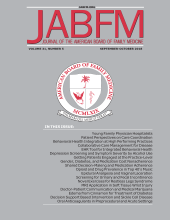Article Figures & Data
Tables
- Table 1.
Variables, Original Survey Questions, and Recoded Factors Used in Analysis of 2003–2004 Data from National Survey of Children's Health
Variable National Survey of Children's Health Question Recoded for Descriptive Analysis Household income as percent of FPL Two variables were used to determine a household's poverty status: the number of people residing in a household and the household's income during the prior year. ≤150% FPL >150% FPL Child's nonschool computer use On an average school day, about how many hours does [the child] use a computer for purposes other than schoolwork? <1 hr between 1 and 2 hr ≥3 hours Child's television use On an average school day, about how many hours does [the child] usually watch television, watch videos, or play video games? <1 hr between 1 and 2 hr ≥3 hours Child's physical activity During the past week, on how many days did [the child] exercise or participate in physical activity for at least 20 minutes that made [him/her] sweat and breathe hard, such as basketball, soccer, running, swimming laps, fast bicycling, fast dancing, or similar aerobic activities? Yes (≥5 days coded as Yes for getting minimum amounts of moderate physical activity) No (<5 days coded as No for not getting minimum amounts of moderate physical activity) Sports team participant During the past 12 months, was [the child] on a sports team or did [he/she] take sports lessons after school or on weekends? Yes No Have health plan Does [the child] have any kind of health care coverage, including health insurance, prepaid plans such as HMOs, or government plans such as Medicaid? Yes No Received all preventive care during the past 12 mo During the past 12 months/Since [the child's] birth, did [he/she] visit [his/her] personal doctor or nurse for preventive care? Yes No (Preventive care visits include things like a well-child check-up, a routine physical exam, immunizations, or health screening tests.) Have PCP Do you have one or more people you think of as [the child's] personal doctor or nurse? Yes No Race Is [the child] white, African-American, American Indian, Alaskan native, Asian, or native Hawaiian or other Pacific Islander? white Not white Sex Is [the child] male or female? Male Female Father/mother meeting at least recommended levels of moderate physical activity? During the past week, on how many days did you exercise or participate in physical activity for at least 20 minutes that made you sweat and breathe hard, such as basketball, soccer, running, swimming laps, fast bicycling, fast dancing, or similar aerobic activities? Yes (≥5 days coded as Yes for getting minimum amounts of moderate physical activity) No (<5 days coded as No for not getting minimum amounts of moderate physical activity) FPL, Federal poverty level; HMO, health maintenance organization.
- Table 2.
Body Mass Index Classification for Age and Gender by Race and Ethnicity (from 2003 to 2004 National Survey of Children's Health Data)
Child's BMI Classification Race and Ethnicity (%) Caucasian (n = 30,713,665)* African American (n = 7,109,284)* Hispanic (n = 5,578,882)* Underweight 6.8 6.1 6.4 Healthy weight 61.0 44.7 49.6 Overweight and obese 32.2 49.2 44.0 * Weighted samples (unweighted n's: Caucasian = 49,854, African American = 6,696, Hispanic = 6,426)
- Table 3.
Description of Overweight and/or Obese School-Aged Children by Race/Ethnicity and the Study's Independent Variables (from 2003 to 2004 National Survey of Children's Health Data)
Covariates Caucasian (n = 9,889,800) African American (n = 3,497,768) Hispanic (n = 2,454,708) Child's household income <150% FPL 31.6 62.2 70.0 Child did not receive preventive care during the past 12 mo 30.7 23.1 30.4 Child not meeting at least recommended levels of moderate PA 32.4 32.4 36.9 Father not meeting at least recommended levels of moderate PA 31.0 29.7 39.3 Mother not meeting at least recommended levels of moderate PA 40.6 45.5 49.2 Child not a sports team participant 53.5 43.4 43.8 Child viewing ≥3 hr of daily television 19.9 36.4 25.1 Child nonschool computer use ≥3 hours daily 8.4 11.8 9.9 All data presented as percents. This represents a weighted analysis. Underweighted children by BMI measure were not included in the analysis.
FPL, Federal poverty level; PA, physical activity.
- Table 4.
Multivariate Logistic Regression Results Characteristics of Overweight and/or Obese School-Aged Children Compared with Healthy Weight Children* (from 2003 to 2004 National Survey of Children's Health Data)
Independent Variables and Factors All US Children African-American Children Hispanic Children White Children Race and ethnicity (white) African-American 1.568 (1.562–1.574) Hispanic 1.298 (1.293–1.303) Sex (female) Male 1.579 (1.575–1.583) 1.279 (1.269–1.288) 1.603 (1.591–1.615) 1.635 (1.630–1.640) Household income (>150% FPL) ≤150% FPL 1.540 (1.535–1.545) 1.219 (1.210–1.229) 2.002 (1.987–2.016) 1.537 (1.531–1.543) Preventive care during past 12 mo (Yes) No 1.540 (1.535–1.545) 1.219 (1.210–1.229) 2.002 (1.987–2.016) 1.537 (1.531–1.543) Father meeting at least recommended levels of moderate PA Not meeting recommended levels of moderate PA 0.902 (0.899–0.904) 0.881 (0.873–0.888) 0.662 (0.657–0.668) 0.948 (0.945–0.951) Mother meeting at least recommended levels of moderate PA Not meeting recommended levels of moderate PA 1.146 (1.143–1.149) 0.995 (0.987–1.003) 1.133 (1.124–1.142) 1.182 (1.178–1.186) Child meeting at least recommended levels of moderate PA Not meeting recommended levels of moderate PA 1.416 (1.412–1.420) 1.605 (1.592–1.618) 1.251 (1.241–1.261) 1.413 (1.409–1.418) Sports Team Participant (Yes) No 1.343 (1.339–1.347) 1.266 (1.256–1.275) 1.508 (1.496–1.519) 1.341 (1.336- 1.345) Child's nonschool computer use (<1 hr) Between 1 and 2 hr 0.942 (0.940–0.945) 1.065 (1.057–1.073) 0.873 (0.866–0.880) 0.925 (0.922–0.928) ≥3 hr 1.091 (1.086–1.096) 0.977 (0.966–0.989) 1.523 (1.502–1.543) 1.081 (1.075–1.088) Child's television use (<1 hr) Between 1 and 2 hr 1.312 (1.308–1.316) 1.249 (1.237–1.261) 0.985 (0.975–0.994) 1.370 (1.365–1.375) ≥3 hr 1.685 (1.678–1.692) 1.565 (1.548–1.582) 1.272 (1.257–1.287) 1.814 (1.805–1.823) All values presented as odds ratio (95% CI). This represents a weighted analysis. Underweighted children by BMI measure were not included in the analysis, nor were children of races/ethnicities other than Caucasian, African American, or Hispanic.







